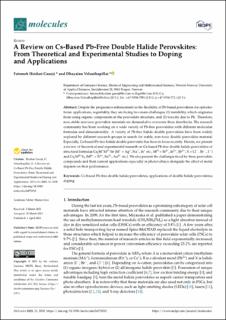| dc.contributor.author | Gourji, Fatemeh Heidari | |
| dc.contributor.author | Velauthapillai, Dhayalan | |
| dc.date.accessioned | 2021-10-13T11:56:05Z | |
| dc.date.available | 2021-10-13T11:56:05Z | |
| dc.date.created | 2021-04-01T20:32:36Z | |
| dc.date.issued | 2021 | |
| dc.identifier.citation | Heidari Gourji, F., & Velauthapillai, D. (2021). A Review on Cs-Based Pb-Free Double Halide Perovskites: From Theoretical and Experimental Studies to Doping and Applications. Molecules, 26(7), 2010. | en_US |
| dc.identifier.issn | 1420-3049 | |
| dc.identifier.uri | https://hdl.handle.net/11250/2792983 | |
| dc.description.abstract | Despite the progressive enhancement in the flexibility of Pb-based perovskites for optoelectronic applications, regrettably, they are facing two main challenges; (1) instability, which originates from using organic components in the perovskite structure, and (2) toxicity due to Pb. Therefore, new, stable non-toxic perovskite materials are demanded to overcome these drawbacks. The research community has been working on a wide variety of Pb-free perovskites with different molecular formulas and dimensionality. A variety of Pb-free halide double perovskites have been widely explored by different research groups in search for stable, non-toxic double perovskite material. Especially, Cs-based Pb-free halide double perovskite has been in focus recently. Herein, we present a review of theoretical and experimental research on Cs-based Pb-free double halide perovskites of structural formulas Cs2M+M3+X6 (M+ = Ag+, Na+, In+ etc.; M3+= Bi3+, In3+, Sb3+; X = Cl−, Br−, I¯) and Cs2M4+X6 (M4+ = Ti4+, Sn4+, Au4+ etc.). We also present the challenges faced by these perovskite compounds and their current applications especially in photovoltaics alongside the effect of metal dopants on their performance. | en_US |
| dc.language.iso | eng | en_US |
| dc.publisher | MDPI | en_US |
| dc.rights | Navngivelse 4.0 Internasjonal | * |
| dc.rights.uri | http://creativecommons.org/licenses/by/4.0/deed.no | * |
| dc.title | A Review on Cs-Based Pb-Free Double Halide Perovskites: From Theoretical and Experimental Studies to Doping and Applications | en_US |
| dc.type | Peer reviewed | en_US |
| dc.type | Journal article | en_US |
| dc.description.version | publishedVersion | en_US |
| dc.rights.holder | © 2021 by the authors. | en_US |
| dc.subject.nsi | VDP::Matematikk og Naturvitenskap: 400 | en_US |
| dc.source.volume | 26 | en_US |
| dc.source.journal | Molecules | en_US |
| dc.source.issue | 7 | en_US |
| dc.identifier.doi | 10.3390/molecules26072010 | |
| dc.identifier.cristin | 1901946 | |
| dc.source.articlenumber | 2010 | en_US |
| cristin.ispublished | true | |
| cristin.fulltext | original | |
| cristin.qualitycode | 1 | |

